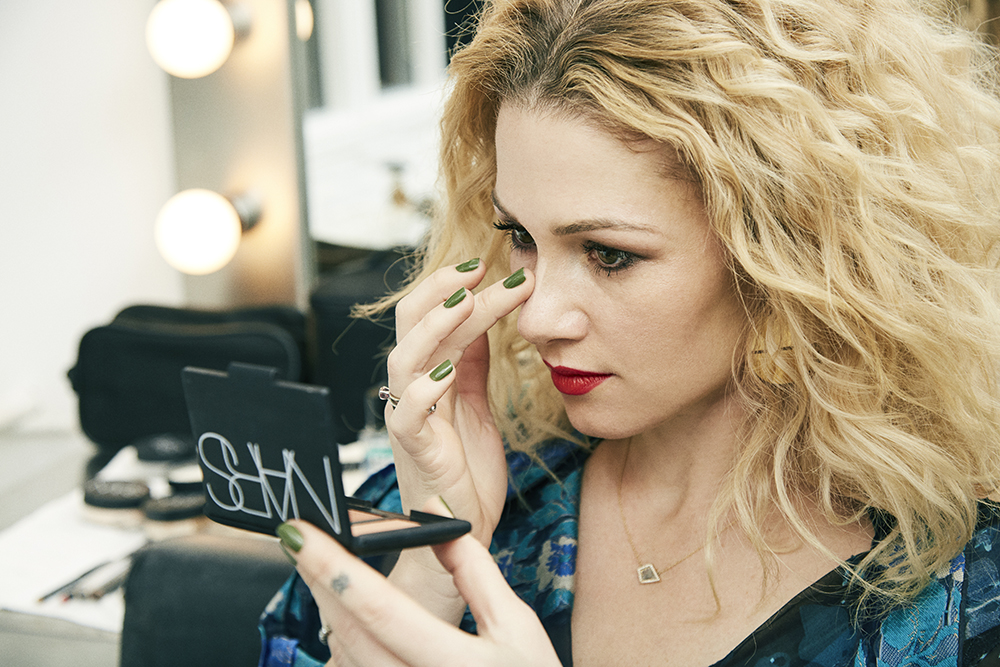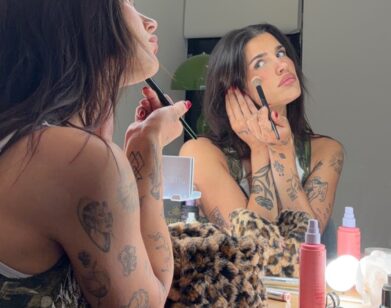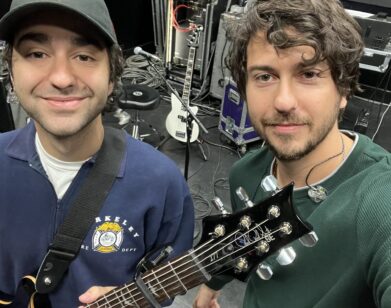Kim Swift
KIM SWIFT IN NEW YORK, JANUARY 2017. MAKEUP: NARS SOFT MATTE COMPLETE CONCEALER IN CUSTARD.
When we think of “experience design,” our minds go to decorators, wedding planners, and the other creative professionals that give the “look” to the events of our lives. For Kim Swift, co-founder of design collective We Came in Peace, crafting these experiences goes far beyond perfecting the aesthetic; the ultimate goal is rather to create a fully immersive experience and kinetic spaces that excite the senses and foster connectivity from within. Swift’s work—which covers and combines all areas of branding, event production, and art direction—is that of a true dreamer, with fantastical visions manifested at the intersection of art, science, advertising, and design. As a part of Interview x NARS Cosmetics’ “The Art Of Throwing Shade,” Swift discusses the nature of experience design; keeping a broad, universal perspective; and being careful to make no apologies in business.
STARTING OUT: What I do now is something I’ve done my whole life. As long as I can remember, I’ve been building my own reality and crafting my own world—creating alternate realities for other people to experience. Only now is there a name and industry for it, which is experience design. I didn’t know how to formalize, structuralize, or make it into a career. When I was in college I studied advertising, which I loved because it was a way to tell stories. That was interesting to me, but on the side I started an art collective with some friends, and we used to take over abandoned spaces to throw art shows. In ad school I partnered up with my partner Andrew [Stevens]. We were each assigned different projects; you could kind of choose what you wanted it to be, and we wanted to design and produce an experience for our entire school. So we threw this massive roller-glam prom for everyone—branded it, sold tickets, even our professors came. Apparently throwing an amazing party doesn’t fit the curriculum for school credit, but that’s okay, because it jump started us on this path. [laughs] Neither he nor I have ever been very good at following any rules—we kind of make our own. But that, in a way, has served us well.
When I moved to New York after college I worked for a small design firm. I learned how to do everything, wear a lot of hats. Ad school really quickly breaks down your ego, so I wanted constructive criticism and was hungry to take on anything that I could. The skills that I learned by being in an environment where people trusted me to take on larger tasks than I had had experience doing, those are the foundation for everything that I’m doing today. It taught me to be a better collaborator, a better worker, a better leader—how to do things like tell people things they don’t wanna hear.
ON SEXISM: The sexism that we experience as women on a day-to-day basis is more often subtle than overt—something that’s so deeply engrained in all of us that we play into it without even knowing it, both men and women. I’ve experienced this a lot: we do a lot of installs, and I once noticed that the crew of guys always called their male superiors “boss,” but never called me that. I realized at that point that they weren’t just going to assume that I was their boss; I had to make it known at the beginning and establish a certain dynamic that was more clearly defined than a male counterpart. Sometimes it’s easier for us to identify what other people do, rather than how we actually undermine ourselves, or dilute our own authority as leaders. The more and more conscious I am of things, the more I feel like I’m creatively crafting strategies that can address these gender dynamics. There’s this app called Just Not Sorry, and what it does is underlines qualifying words or phrases like “I’m no expert” or “just” or “I’m sorry.” That incremental amount of communication is something that dilutes our power as leaders and minimizes the confidence that others have in us. The greatest impact of that is that it enables us to take notice of the things that we’re doing which undermine ourselves so that we can make subtle behavioral shifts in the right direction. When you’re in a leadership role, when you’re a boss and you’re a woman, it involves finding creative strategies that work for you and help you address gender dynamics more effectively. The idea of “shade” is one of the tactics; it’s not hurling an insult, but it’s about humor, wit, creativity—crafting an artful response to the situation that will hopefully diffuse it and allow you to move on with your day.
FEELING EMPOWERED: Sometimes I like to do what I call time traveling; I’ll think of where I was last year at this exact time, and then the year before that, and the year before that. I keep track of these moments in my mind as a way to see the upward movements that I might not be able to see everyday. It’s all perspective. Astronauts talk about the overview effect; when they go to space, they’ll come back and have this extreme cognitive shift in awareness when they’ve seen how tiny our Earth looks. We just can’t see it because we’re so caught up in our everyday lives.
Culturally, we’re experiencing a shift—it’s a shared experience that we’re having right now, looking to find our connectivity with the universe. I do have this perspective as a matter of framing the context of my life: with my work, just knowing that I’m a tiny human. My greatest joy and purpose would be to create work that is meaningful to humans. If I can do that, I’m using my gift to serve my community in this way. I think about the community of women, also—it’s important for them to come together in the way that they are right now. Feeling that support of other women behind you is incredibly inspiring as well. It’s beautiful to think about this next generation of women and men who are going to grow up with a woman that’s run for president, seeing women in confident leadership roles; that’s going to be their normal, and I think that’s how change happens.
BEAUTY AND CONFIDENCE: I think that your appearance is the first thing that you communicate to people. That doesn’t necessarily mean that you have to be more feminine or be any one way other than who you are as your authentic self. I think the only wrong way to present yourself is as someone that you’re not. The sexiest and most beautiful that you are is when you’re truly comfortable and confident in your authentic self—knowing who you are, putting that out into the world unapologetically. Sometimes it can take a minute to really listen to yourself and come to an understanding of who that is. But I think deep down you always know the answers. It’s about tapping into what brings you the most joy, tapping into your passion and what you know is right for you; that’s your power, that’s your magic. I’ve often played with the idea of representing or styling myself in different ways for different meetings: meeting with a brand and styling myself in a way that I know represents their culture and aesthetic. I enjoy taking on that transformative role of communicating that I understand them; I’m a mirror and reflection of them.
FOR MORE FROM “THE ART OF THROWING SHADE,” CLICK HERE.







